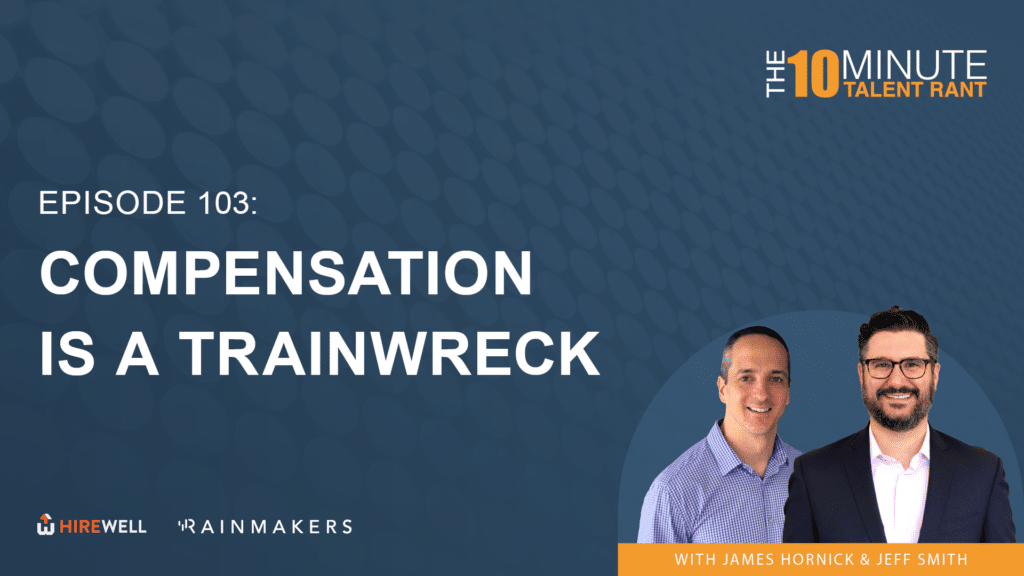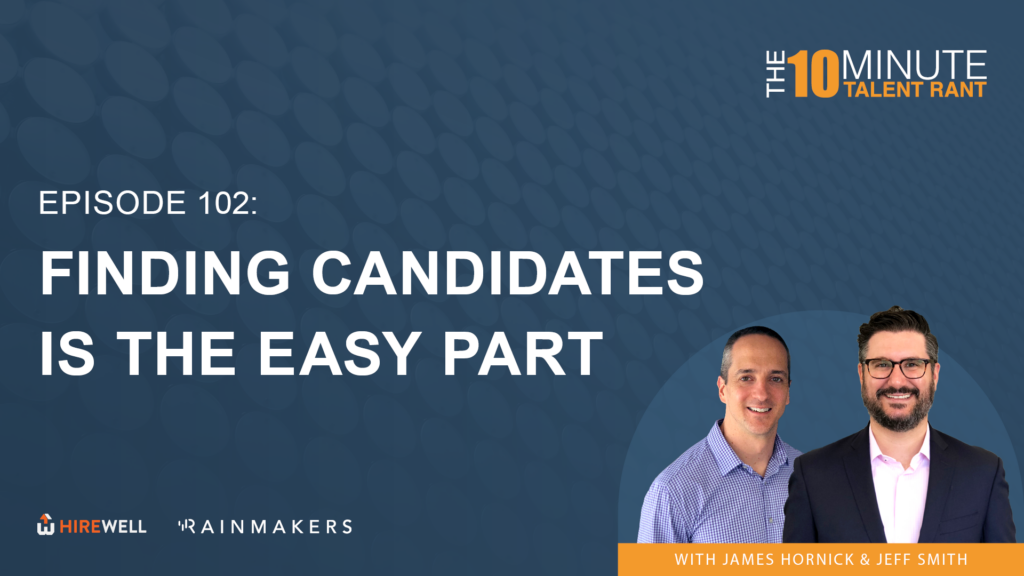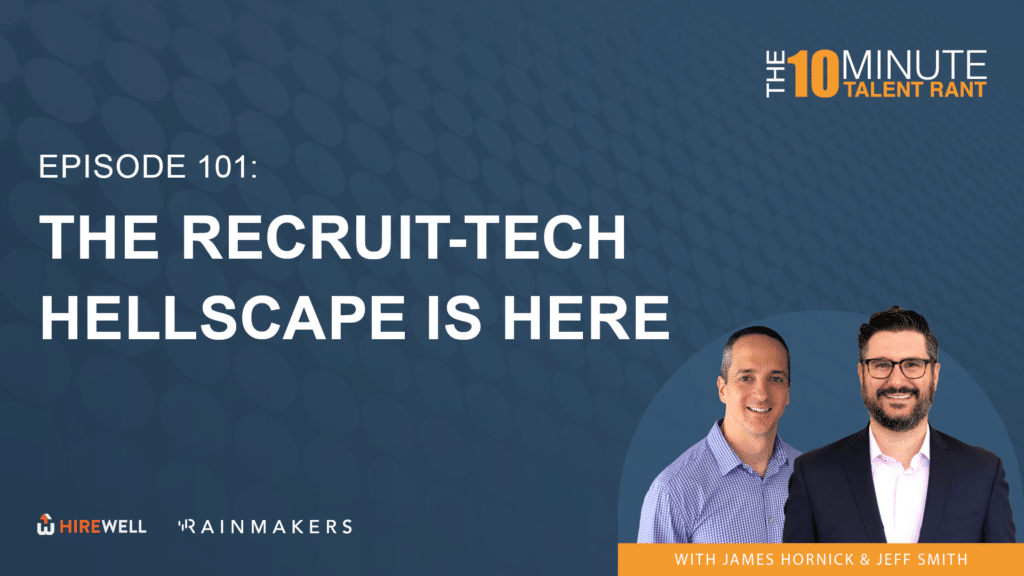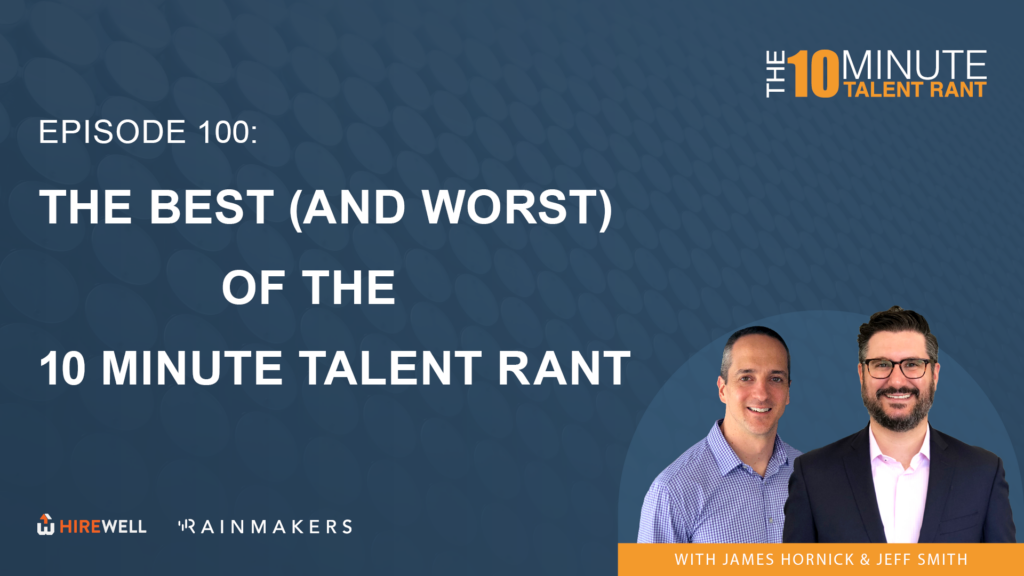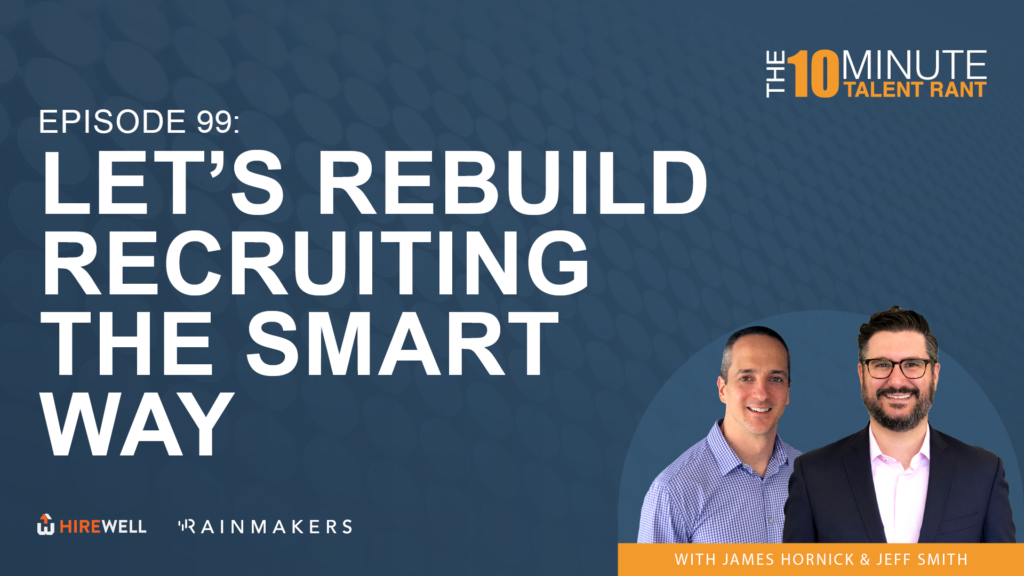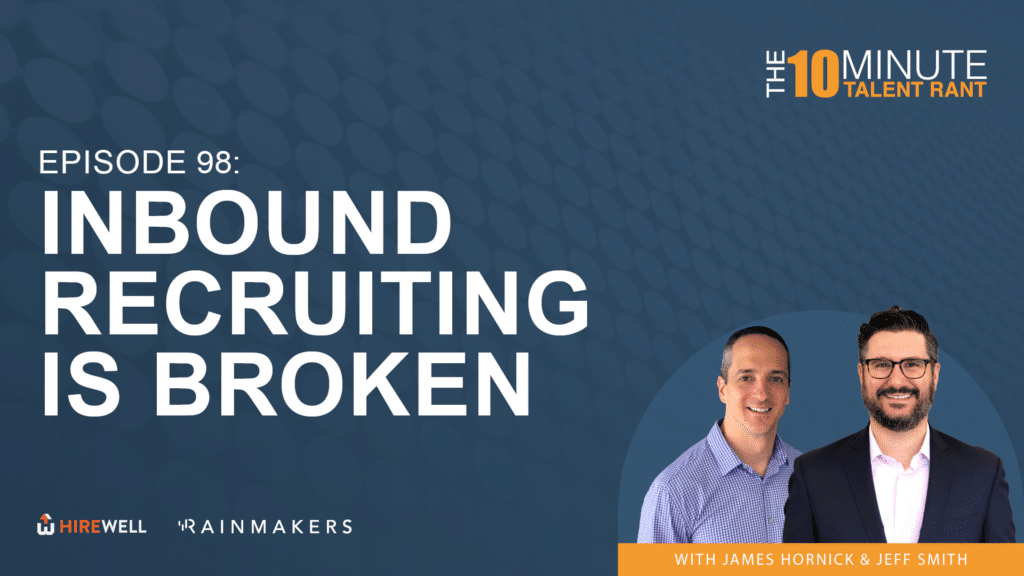The 10 Minute Talent Rant is live. I’m James Hornick, joined by Jeff Smith, and we are on the clock. The 10 Minute Talent Rant is our ongoing series where you break down things that are broken into talent acquisition and hiring space. Maybe even pitch a solution or two. Before we dig in, all of our content can be found at talentinsights.hirewell.com.
This week’s episode, episode 57: “Why Crappy Recruiting Firms Still Exist.” Jeff, you got a short answer for this one? Yeah, because crappy TA departments keep hiring them. That’s a wrap for this week. Thanks for tuning into the 10 minute talent rant. We should elaborate. Another year, another new take on a classic, why people hate recruiters.
The good thing about working in an industry with a less than stellar reputation is it’s easy to stand out and differentiate yourself. Yeah. The bad thing is, is that you have to actually do it, though. It’s just totally exhausting to go into every conversation with a potential candidate or potential client, it being an uphill battle, explaining to them why you don’t suck.
Because they’re expecting most people they talk to, to. Yeah. When you’re in an industry where everyone stinks, it would probably beg to say that it’s got to be a hard job. So anyway, look. What does crappy look like? For those who want a definition of it, so we’re talking resume mills, these types of organizations.
If you’ve hired one, you know, they’ll submit anyone. There’s no vetting. You get on the phone, you’re like, “Why am I talking to this person?” Internally there’s like a hard sell mentality. There’s poor follow up. There’s ghosting both on your end as the customer and even worse, on the candidate side, this is where all of these ghosting posts come from.
And it’s because they’re kids, by and large, they’re not us. We’re the gray hairs that made it out. Look, we all got minimal training. We were all paid nothing. I didn’t own a vacuum cleaner for like two years. I got work to the bone. So did you. We’re just kind of given these strict and ridiculous activity numbers to just work towards. It’s busy work, so it leads to high turnover.
Leadership doesn’t care because they’re making ridiculous margins off of all of the placements that they do make. The too long didn’t read, is they just make a bunch of money without providing a ton of value for the customers. Or by extension, a positive work environment for their people. Yeah.
And those two things are highly related, which I’ll stand by. It’s absolutely gross to me. And I feel bad for every new recruiter who has to start in the industry and goes to one of these places like Jeff and I and the rest of the Hirewell partners. Like it’s been our mission to build an organization that’s the opposite of that.
Every experienced recruiter, whether it’s with us or with other good firms that are out there, they walk into conversations trying to prove that they’re not like those places. And it’s like I said before, it’s kind of exhausting. So again, why do they still exist? And Jeff already literally gave the answers before.
It’s because crappy recruiting firms exist because crappy TA departments view recruiting agencies as a tactical means to an end, not as an actual strategic function of how they can better themselves and better their organization. Yeah. I think there’s two ways to look at this.
Two spaces. And these are broad kind of buckets. I think it does get a little bit more granular, but you look at the small medium business bucket and like large company RFP bucket, both of them vary by design point towards non-exclusive contingent type model. So on the SMB front, you’ve got a lot of direct hire for the most part.
A lot of those places aren’t set up well enough to withstand contracting. They don’t want to spend a lot, naturally. Nobody wants to spend too much. Yeah, I get that. There has to be some risk aversion to spend. Funds are limited. I think there’s some disagreement in these sizes of organizations on what the role is, who the person is.
And just the general overall fear of hiring the wrong person. And I think that’s a separate rant entirely, but we’ll leave that for another day. On the flip side, you’ve got large organizations, Fortune 500, that are almost always exclusively RFP bureaucratic red tape lace, races to the bottom.
The i.e., the lowest rate wins the opportunity to submit. And that opportunity isn’t even exclusive. So what are the main issues at play here? All right, there’s three. I’m going to take my favorite one. Non-exclusive work. Contingent work. Talked about this. I think we’ve done a-
we might have done multiple rants on this before. Any other industry? I mean real estate industry, a handful of sales industries, ambulance chasing lawyers. That’s pretty much it. What other organizations will take on a client without actually expecting some sort of commitment or money or anything upfront? I mean, if you’re only looking for contingent or you’re only looking for recruiting work on a contingent basis, contingent lens, guess what?
So does that agency. Yep. You know, they’re also looking at the same thing. They’re going to make a first few submissions. If they don’t get a quick deal, they’re moving on to the next thing. Like you’re not their priority ever, which is why these searches and things can happen. Like you get such a poor service that might just disappear.
If your play is, the more firms I have in an opening, the better, bad news for you there too. All you’re doing is getting the first three to five candidates they find. So it’s most likely recruiter is just checking email at their desk. You know? Sounds ridiculous. But Jeff, that was you, right? I literally sat in that seat for almost three years.
Watch your email and wait for a requirement to come in and find the first two people that fit. You get zero deep market experience. Most likely you’re just getting some kid right at school who was assigned to it, and they’re just hoping something good comes in. They can send it out to you. You’re getting little Jeff.
When it’s contingent, there’s also no reason to be selective, and by selective I mean by that things they actually work on. They will take any single requirement that comes across their desk. Why not? F it. Why not? It’s just all the time these folks spend chasing other deals, cuts directly, when I say other deals, other potential clients that never even pan out because they weren’t good requirements to work on.
It just cuts away the time they can be investing in your company on something that’s real. On something you actually need done. Yeah, but they don’t care because in that world, time is money anyway. Issue two, predetermined SLAs. This is one that we really haven’t touched on, but I think is super important in other rants, I should say.
So shitty recruiting firms, as you just said. They’ll say yes to anything. And taking every contingent role that comes past their desk. You know what else they say yes to? Every single SLA or KPI that you, customer, put in front of them. Again, because why the F not? It makes no difference.
So why would any remotely strategic recruiter agree to predetermined SLAs without a deliberate, deep kind of vetting of the customer requirement of the role, making sure that they understand what the job is, right? So every client culture is different and by extension. Every recruiting function radically different in a lot of cases.
So agreeing to these arbitrary KPIs that have no basis in the actual work product or the success of the search is completely silly. Yeah. And if the SLAs, and I guess we need to say this, if the SLAs seem reasonable, that’s fine. We’re not saying there shouldn’t be accountability or something built in, but having broad general SLAs determining success, failure for any search, without knowing the granular specifics of that individual search and just having the same broad-based SLAs across the board, it’s not something any reasonable person would take on or say yes to.
If they are saying yes to, it’s because they don’t understand the space or if they’re saying yes to it across a bunch of different rolls up, breaking ’em all down individually. You know, you’re not talking to someone who actually has been around the block and has actually done this before. Yes. It’s also the reason, you know, tldr also the reason why you’re getting 26 submissions, that one supplier, but never seem to actually get anything filled from them.
Yes. They’re just throwing paper on the wall. But all of your metrics are based off of that supplier, because you like the idea of the resume mill. You like seeing this activity every day. But there’s no value to it, and it’s increasingly pissing off the actual good suppliers who are taking their time and finding the right candidates. Again, probably another rant.
Third, issue three, rate cards. This is the coup de grâce, the big winner of the shitty firm problem. So within VMS systems, which is generally speaking, how recruiting is performed, operationally within a large org, there’s always rate cards. And again, I’m not saying that there shouldn’t be guardrails around spend.
Okay. Same. But the cards are built to suffocate wages and it makes it way harder for recruiting firms on those lists to recruit for the openings. So your net result in a poorly run program is that it produces inferior candidates by design. The only vendors that can stomach that list are the crappy recruiting firms.
Yeah. So no decent firm participates in these things. None. Zero. You have to pay your recruiters, nothing for it to actually work. None. And when you pay your recruiters nothing, what kind of quality you think you’re going to get in terms of the actual service. We’ve considered them. And every single time we go down it without fail, it ends up at 60%, 60 to 70% of market rate.
And it’s just not tenable. So the second part of this is, you know, enough companies run this, that there’s this illusion that it’s the market rate. Yeah, it’s a market rate. It’s a market rate of the candidate pool that couldn’t secure jobs and hire paying more competitive seats. So again, the whole process is literally why the shitty firm still exists.
Yeah. Now, takeaways from this one. If you haven’t heard, if you haven’t considered this out, rate cards before, SLAs before, we definitely hit you with some new stuff today. Or just the concept of why you shouldn’t just go with contingent firms and hire five of ’em at the same time. I realize you may have come from a different space.
It might be new to you. Maybe it’s all you’ve ever known. I don’t expect this to render this conversation to kind of change your mind, but I guess what I do ask is that, keep an open mind that it might be better ways to find talent that represent your company better. Represent, you know, or more strategic about the way you can be kind of envisioning filling positions. Jeff and I are happy to talk about any time, but there’s-
if this is all you know and all you’re used to, there’s definitely another gear out there in terms of the types of firms you should work with. Totally. If you keep viewing it as the last ditch effort and, you know, beat up those suppliers in the process, they’re going to keep viewing it for what it is.
Just, you know, another quick hit invoice. And we are short on clock. That’s a wrap for this week. Thanks again for tuning in the 10 Minute Talent Rant,, part of the Talent Insights series, which is always available for replay on talentinsights.hirewell.com, as well as YouTube Apple Podcast, Google Podcast, Spotify, and Amazon.
That’s the first one for the year. So, Happy New Year, everyone out there, Jeff. Looking forward to more rants in 2023. In my new office.







